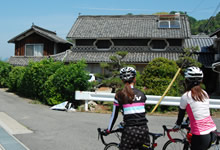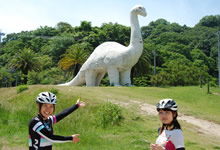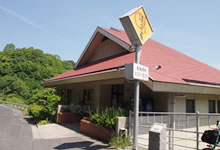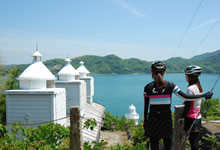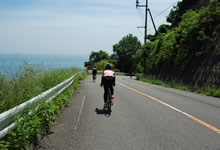Cycling across islands while enjoying the beautiful sea and the flesh sea breeze
On your bike seat, get ready to encounter amaizing scenery you will never experience in a car seat.


Today we're cycling around Innoshima Island. We start on Ikuchijima Island and go across Ikuchibashi Bridge to get there. To tell the truth, I actually haven't been to Innoshima Island many times. I wonder what's there? What kinds of adventures will we have? I'm looking forward to it.
Ikuchibashi Bridge is a 790-meter cable-stayed bridge. After seeing Tatara Ohashi Bridge, I felt that it looked a little plain, but apparently at the time of its completion in 1991, it was the world's longest bridge of its type. The story goes that the many engineering techniques used in the construction of Ikuchibashi Bridge became a great resource that enabled the creation of Tatara Ohashi Bridge, which replaced it as the world's longest cable-stayed bridge. When you think about it that way, there's actually something pretty amazing about this Ikuchibashi Bridge. We cycled across it feeling great. The scenery from atop the bridge was a magnificent expanse of blue. I couldn't take my eyes off of it.
We passed many motorcycles touring around the island while we cycled. Motorcycles and bicycles use the same lane, so it's important to be careful! Right in front of the entrance to the cycling lane is a spot where you can get a beautiful view of Ikuchibashi Bridge. It seemed so short while we were cycling it, but viewing it from here, it actually looks quite long!
We continue along Route 317. In this area, there are many stores lining the street: a big appliance shop, a supermarket, a convenience store, a shop with pachinko slot machines, and others. There are also lots of cars and people. The cars pass by really close - there's a blue line indicating the cycling lane, but it's still a little scary. Compared with the other islands, this area on Innoshima is a little difficult to cycle.
We turn left from Route 317 onto Route 366. Following this straight road which borders the sea, we arrive in an area called Shigei-cho. The town of Shigei is a port area where many old Japanese-style houses remain. There are many houses shaped like storehouses, featuring windows bordered decoratively with plaster. It looks like people are still living in the houses. I like the character of this area. The old-fashioned environs make you feel as if you've slipped back into another era.
We saw some beautiful white flowers on the mountain slope, blooming in the terraced fields built with rows of stacked stones. I wondered what kind of flower they were and found out later that they're called dalmatian chrysanthemums.
Innoshima Island is apparently a well-known place for these flowers. They used to be cultivated as a raw material for a special type of incense that keeps mosquitoes away. In those times, the island used to be covered in white when May came around. Now, since chemical insect repellents have become more popular, the flowers are grown to attract visitors and sightseers instead.
After returning to Route 366 and continuing along it for a little while, we came to a small hill. This is the first hill we've come across since arriving on Innoshima Island. It's a little steep! But from this area onwards cars become more scarce, so it gets easier to cycle comfortably.
There's a large park near Innoshima Ohashi Bridge. As we were riding along it, we came across a white dinosaur! But why a dinosaur? Anyways, we decided to take a picture with it. This spacious park is called Innoshima Ohashi Kinen Koen Park, since it's near the Innoshima Ohashi Bridge, which connects Innoshima Island with the neighboring Mukaishima Island.
I heard that Hassaku-ya, a popular Japanese confectionery that used to be near Ikuchibashi Bridge, had moved its location to a place near Innoshima Ohashi Kinen Koen Park, so we went to check it out. The shop is famous for hassaku daifuku, a treat made with fresh hassaku citrus wrapped in sweet rice cake. At the bottom of the hill is a sign with the shop name. It's a short distance, but the hill is steep! We'll motivate ourselves with thoughts of the delicious hassaku daifuku on the other side.
From the shop, you can see Innoshima Ohashi Bridge right in front of you. It's a perfect location. Apparently an old rest house that was here was remodeled into the present shop. There were a lot of cyclists out front - there are bicycle stands inside, so you can bring your bike into the store. And there are all kinds of delicious daifuku on display. There are daifuku filled with ingredients like fresh strawberries or red beans - but we had to get the famous hassaku daifuku! The tart hassaku citrus balances the sweetness of the bean paste exquisitely. Now this is absolutely delicious.
On the way to Hassaku-ya, we saw a small sign that read "灯台記念館", Lighthouse Museum. It looked like a narrow path leading through the woods. Wondering how far we could go, we pushed our bikes along the path carpeted with fallen leaves until we encountered an incredible sight. In front of us was a white lighthouse and the beautiful blue sea. It took our breath away.
The lighthouse museum is housed in the former keeper's quarters. We could view the displays through the windows from the outside, but we weren't able to go inside the building. Innoshima Ohashi Bridge was visible right in front of us. You can go down to the lighthouse from behind the museum. Since we came all the way out here, we decided to check it out. We were captivated again by the clarity of the seawater that was visible on our way down. The lighthouse is really beautiful from up close, too. It's a moving sight. Who knew there was such a place on Innoshima Island? There are no tourists to be seen. Maybe this is one of Innoshima's best kept secrets.
The road becomes flat for a while once you get past the overpass. we cycled along at a relaxed pace while gazing at the sea. Since we filled up on hassaku daifuku, we're headed toward Innoshima Suigun Skyline. Once we returned to Route 366 from the museum commemorating the famous Go player, Shusaku Hon'inbou, the road began sloping gradually upward. The Innoshima Suigun Skyline course is an intense nine kilometer route with lots of ups and downs. It's famous as a great place to go driving and view the scenery... but are we really going to be able to do this on bicycles!?
We felt pretty good at the outset, but eventually we began chatting less and less until we were cycling along silently. Just after we started cycling up the Skyline, we came across an elementary school-aged boy and two young moms. Apparently they cycled all the way here from Onomichi. I was surprised to hear that they planned on cycling up the Skyline with their baby-seat attached bicycles! I couldn't help feeling a little worried about them! We passed them eventually… I wondered if they were alright? Were they able to make it all the way to the end of the route? I really hope everything went well.
We passed some other cyclists on the Skyline, but they were all cycling enthusiasts who looked like they enjoy hillclimbing. Besides the family earlier, there weren't any other leisure cyclists like us on the route. This cycling course is definitely best suited for active riders.
Of course, even cyclists like us can enjoy the Skyline by going at a slow pace. But it's a pretty long distance with a lot of hills, so you have to be mentally prepared for a hard course. Since the road climbs quite high above sea level, the views are exceptional. There's also a spot along the way that was chosen as one of Innoshima Island's top eight beautiful views. I recommend taking regular breaks and enjoying the gorgeous scenery as you cycle the Skyline. There aren't too many vehicles passing through, but we did encounter a couple cars going very fast, so it's important to be careful, especially around curves in the road.
It's also important to note that there aren't any shops along the route. There was one rest stop with a restroom, but the whole route is basically a mountain road, so it's best to eat something and use the restroom before heading up the Skyline.
Once we got to a town called Habu, we began seeing more and more people and cars. we cycled along at an easy pace, being careful of the cars that passed close to us. Since there is a ferry terminal at Habu-ko Port, I decided to have a look. The island right before our eyes is Ehime Prefecture's Ikinajima Island. Even though it's so close that it practically looks like you could swim there, it belongs to the neighboring Ehime Prefecture. The ferry was chugging along back and forth between the two islands. Islands without a bridge seem pretty interesting, too!
We had a late lunch at an Italian restaurant in Takuma called Tre Bambini. It's in a great location right next to the sea.
Taking Route 366, we head back to the area around Ikuchibashi Bridge. From Habu to Ikuchibashi Bridge, the road is pretty flat without many ups and downs. It's also wider, so it's easier to cycle. After passing Kanayama-ko Port, you can see Ikuchibashi Bridge stretching out before you.
We cycled all the way along the island following the coast today. The total distance cycled was 30 kilometers, but for over a quarter of that we were cycling along the clifftops of Innoshima Suigun Skyline's intense up-and-down course. That portion was even harder than I thought it would be. I'm definitely going to be sore tomorrow! But there are incredible views waiting along the route.
Each side of Innoshima Island has a different feel. The west side is a bustling area with narrow roads lined with houses and shops. The north side features the relaxed, old-town area of Shigei. On the east side, you can enjoy dramatic views from Innoshima Skyline. And the south side is a large shipbuilding area. The islands along the Shimanami Kaido are unique because you can see so many different kinds of scenery on just one island. But remember to be careful as there are areas where many cars are passing by.
